Publications
Objectifying Social Presence: Evaluating Multimodal Degraders in ECAs Using the Heard Text Recall Paradigm

Embodied conversational agents (ECAs) are key social interaction partners in various virtual reality (VR) applications, with their perceived social presence significantly influencing the quality and effectiveness of user-ECA interactions. This paper investigates the potential of the Heard Text Recall (HTR) paradigm as an indirect objective proxy for evaluating social presence, which is traditionally assessed through subjective questionnaires. To this end, we use the HTR task, which was primarily designed to assess memory performance in listening tasks, in a dual-task paradigm to assess cognitive spare capacity and correlate the latter with subjectively-rated social presence. As a prerequisite for this investigation, we introduce various co-verbal gesture modification techniques and assess their impact on the perceived naturalness of the presenting ECA, a crucial aspect fostering social presence. The main study then explores the applicability of HTR as a proxy for social presence by examining its effectiveness under different multimodal degraders of ECA behavior, including degraded co-verbal gestures, omitted lip synchronization, and the use of synthetic voices. The findings suggest that while HTR shows potential as an objective measure of social presence, its effectiveness is primarily evident in response to substantial changes in ECA behavior. Additionally, the study also highlights the negative effects of synthetic voices and inadequate lip synchronization on perceived social presence, emphasizing the need for careful consideration of these elements in ECA design.
@ARTICLE{11271093,
author={Ehret, Jonathan and Schüppen, Jonas and Mohanathasan, Chinthusa and Ermert, Cosima A. and Fels, Janina and Schlittmeier, Sabine J. and Kuhlen, Torsten W. and Bönsch, Andrea},
journal={IEEE Transactions on Visualization and Computer Graphics},
title={Objectifying Social Presence: Evaluating Multimodal Degraders in ECAs Using the Heard Text Recall Paradigm},
year={2025},
volume={},
number={},
pages={1-15},
doi={10.1109/TVCG.2025.3636079}
}
Audiovisual angle and voice incongruence do not affect audiovisual verbal short-term memory in virtual reality

Virtual reality (VR) environments are frequently used in auditory and cognitive research to imitate real-life scenarios. The visual component in VR has the potential to affect how auditory information is processed, especially if incongruences between the visual and auditory information occur. This study investigated how audiovisual incongruence in VR implemented with a head-mounted display (HMD) affects verbal short-term memory compared to presentation of the same material over traditional computer monitors. Two experiments were conducted with both these display devices and two types of audiovisual incongruences: angle (Exp 1) and voice (Exp 2) incongruence. To quantify short-term memory, an audiovisual verbal serial recall (avVSR) task was developed where an embodied conversational agent (ECA) was animated to speak a digit sequence, which participants had to remember. The results showed no effect of the display devices on the proportion of correctly recalled digits overall, although subjective evaluations showed a higher sense of presence in the HMD condition. For the extreme conditions of angle incongruence in the computer monitor presentation, the proportion of correctly recalled digits increased marginally, presumably due to raised attention, but the effect size was negligible. Response times were not affected by incongruences in either display device across both experiments. These findings suggest that at least for the conditions studied here, the avVSR task is robust against angle and voice audiovisual incongruences in both HMD and computer monitor displays.
@article{ Ermert2025,
doi = {10.1371/journal.pone.0330693},
author = {Ermert, Cosima A. AND Yadav, Manuj AND Ehret, Jonathan AND
Mohanathasan, Chinthusa AND Bönsch, Andrea AND Kuhlen, Torsten W. AND
Schlittmeier, Sabine J. AND Fels, Janina},
journal = {PLOS ONE},
publisher = {Public Library of Science},
title = {Audiovisual angle and voice incongruence do not affect
audiovisual verbal short-term memory in virtual reality},
year = {2025},
month = {08},
volume = {20},
url = {https://doi.org/10.1371/journal.pone.0330693},
pages = {1-23},
number = {8},
}
Demo: A Latency-Optimized LLM-based Multimodal Dialogue System for Embodied Conversational Agents in VR

Interactions with Embodied Conversational Agents (ECAs) are essential in many social Virtual Reality (VR) applications, highlighting the growing demand for free-flowing, context-aware conversations supported by low-latency, multimodal ECA responses. We introduce a modular, extensible framework powered by an Large Language Model (LLM), featuring streaming-based optimization techniques specially crafted for multimodal responses. Our system is capable of controlling self-behavior and task execution, in the form of moving through the Immersive Virtual Environment (IVE) directly controlled by the LLM, and is also capable of reacting to events in the IVE. In our study, our applied optimizations achieved a latency improvement of about (66%) on average compared to having no optimizations.
» Show BibTeX
@inproceedings{Kuehlem2025,
author = {W. K\"{u}hlem, Konstantin and Ehret, Jonathan and W. Kuhlen, Torsten and B\"{o}nsch, Andrea},
title = {A Latency-Optimized LLM-based Multimodal Dialogue System for Embodied Conversational Agents in VR},
year = {2025},
isbn = {9798400715082},
publisher = {Association for Computing Machinery},
doi = {10.1145/3717511.3749287},
abstract = {Interactions with Embodied Conversational Agents (ECAs) are essential in many social Virtual Reality (VR) applications, highlighting the growing demand for free-flowing, context-aware conversations supported by low-latency, multimodal ECA responses. We introduce a modular, extensible framework powered by an Large Language Model (LLM), featuring streaming-based optimization techniques specially crafted for multimodal responses. Our system is capable of controlling self-behavior and task execution, in the form of moving through the Immersive Virtual Environment (IVE) directly controlled by the LLM, and is also capable of reacting to events in the IVE. In our study, our applied optimizations achieved a latency improvement of about (66\%) on average compared to having no optimizations.},
booktitle = {Proceedings of the 25th ACM International Conference on Intelligent Virtual Agents},
articleno = {49},
numpages = {3},
series = {IVA '25}
}
Poster: Listening Effort In Populated Audiovisual Scenes Under Plausible Room Acoustic Conditions

Listening effort in real-world environments is shaped by a complex interplay of factors, including time-varying background noise, visual and acoustic cues from both interlocutors and distractors, and the acoustic properties of the surrounding space. However, many studies investigating listening effort neglect both auditory and visual fidelity: static background noise is frequently used to avoid variability, talker visualization often disregards acoustic complexity, and experiments are commonly conducted in free-field environments without spatialized sound or realistic room acoustics. These limitations risk undermining the ecological validity of study outcomes. To address this, we developed an audiovisual virtual reality (VR) framework capable of rendering immersive, realistic scenes that integrate dynamic auditory and visual cues. Background noise included time-varying speech and non-speech sounds (e.g., conversations, appliances, traffic), spatialized in controlled acoustic environments. Participants were immersed in a visually rich VR setting populated with animated virtual agents. Listening effort was assessed using a heard-text-recall paradigm embedded in a dual-task design: participants listened to and remembered short stories told by two embodied conversational agents while simultaneously performing a vibrotactile secondary task. We compared three room acoustic conditions: a free-field environment, a room optimized for reverberation time, and an untreated reverberant room. Preliminary results from 30 participants (15 female; age range: 18–33; M = 25.1, SD = 3.05) indicated that room acoustics significantly affected both listening effort and short-term memory performance, with notable differences between free-field and reverberant conditions. These findings underscore the importance of realistic acoustic environments when investigating listening behavior in immersive audiovisual settings.
Interactive Streaming of 3D Scenes to Mobile Devices using Dual-Layer Image Warping and Loop-based Depth Reconstruction
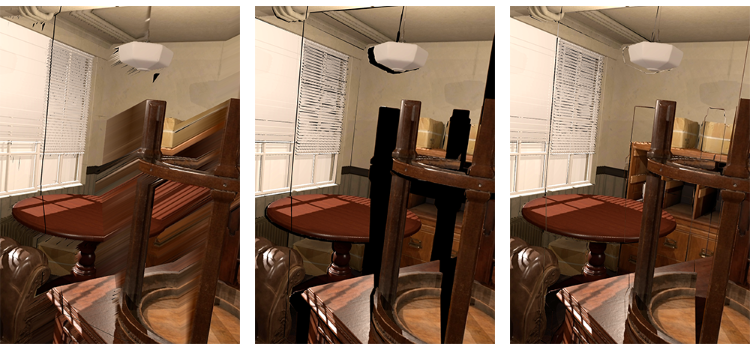
While mobile devices have developed into hardware with advanced capabilities for rendering 3D gra-phics, they commonly lack the computational power to render large 3D scenes with complex lighting interactively. A prominent approach to tackle this is rendering required views on a remote server and streaming them to the mobile client. However, the rate at which servers can supply data is limited, e.g., by the available network speed, requiring image-based rendering techniques like image warping to compensate for the latency and allow a smooth user experience, especially in scenes where rapid user movement is essential. In this paper, we present a novel streaming approach designed to minimize arti-facts during the warping process by including an additional visibility layer that keeps track of occluded surfaces while allowing access to 360° views. In addition, we propose a novel mesh generation techni-que based on the detection of loops to reliably create a mesh that encodes the depth information requi-red for the image warping process. We demonstrate our approach in a number of complex scenes and compare it against existing works using two layers and one layer alone. The results indicate a significant reduction in computation time while achieving comparable or even better visual results when using our dual-layer approach.
@ARTICLE{Koenen-2025-A05,
author={Koenen,J. and Oehrl,S. and Kuhlen,T. and Gerrits,T.},
title={Interactive Streaming of 3D Scenes to Mobile Devices using Dual-Layer Image Warping and Loop-based Depth Reconstruction},
journal={Journal of WSCG},
year={2025},
volume={33},
number = {1},
pages={1-10},
doi={10.24132/JWSCG.2025-1},
publisher={Union Agency, Science Press},
issn={1213-6972},
document_type={Article},
}
Towards Comprehensible and Expressive Teleportation Techniques in Immersive Virtual Environments

Teleportation, a popular navigation technique in virtual environments, is favored for its efficiency and reduction of cybersickness but presents challenges such as reduced spatial awareness and limited navigational freedom compared to continuous techniques. I would like to focus on three aspects that advance our understanding of teleportation in both the spatial and the temporal domain. 1) An assessment of different parametrizations of common mathematical models used to specify the target location of the teleportation and the influence on teleportation distance and accuracy. 2) Extending teleportation capabilities to improve navigational freedom, comprehensibility, and accuracy. 3) Adapt teleportation to the time domain, mediating temporal disorientation. The results will enhance the expressivity of existing teleportation interfaces and provide validated alternatives to their steering-based counterparts.
Exploring Gaze Dynamics: Initial Findings on the Role of Listening Bystanders in Conversational Interactions
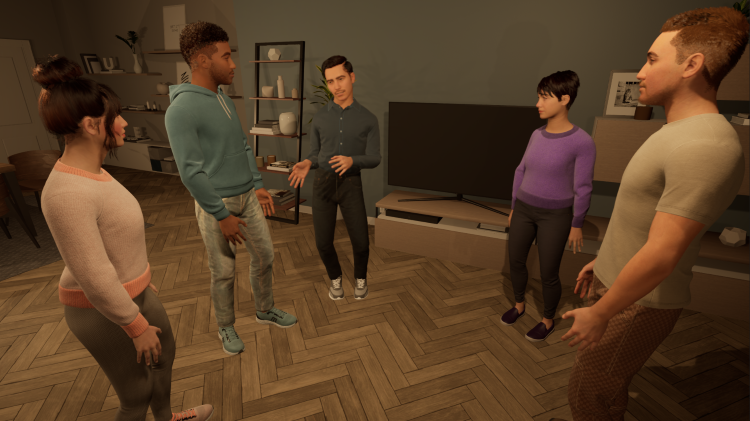
This work-in-progress paper investigates how virtual listening bystanders influence participants’ gaze behavior and their perception of turn-taking during scripted conversations with embodied conversational agents (ECAs). 25 participants interacted with five ECAs – two speakers and three bystanders – across three conditions: no bystanders, bystanders exhibiting random gazing behavior, and social bystanders engaging in mutual gaze and backchanneling. Participants either observed the conversation or actively participated as speakers by reciting prompted sentences. The results indicated that bystanders reduced the participants’ attention to speakers, hindering their ability to anticipate turn changes and resulting in longer delays in shifting their gaze to the new speaker after an ECA yielded the turn. Random gazing bystanders were particularly noted for obscuring conversational flow. These findings underscore the challenges of designing effective and natural conversational environments, highlighting the need for careful consideration of ECA behaviors to enhance user engagement.
@INPROCEEDINGS{Ehret2025,
author={Ehret, Jonathan and Dasbach, Valentin and Hartmann, Jan-Nikjas and
Fels, Janina and Kuhlen, Torsten W. and Bönsch, Andrea},
booktitle={2025 IEEE Conference on Virtual Reality and 3D User Interfaces
Abstracts and Workshops (VRW)},
title={Exploring Gaze Dynamics: Initial Findings on the Role of Listening
Bystanders in Conversational Interactions},
year={2025},
volume={},
number={},
pages={748-752},
doi={10.1109/VRW66409.2025.00151}}
Front Matter: 9th Edition of IEEE VR Workshop: Virtual Humans and Crowds in Immersive Environments (VHCIE)
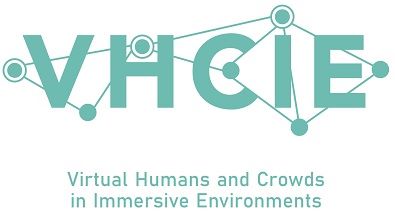
The VHCIE workshop aims to explore and advance the creation of believable virtual humans and crowds within immersive virtual environments (IVEs). With the emergence of various tools, algorithms, and systems, it is now possible to design realistic virtual characters - known as virtual agents (VAs) - that can populate expansive environments with thousands of individuals. These sophisticated crowd simulations facilitate dynamic interactions among the VAs themselves and between VAs and virtual reality (VR) users. The VHCIE workshop seeks to highlight the diverse range of VR applications for these advancements, including virtual tour guides, platforms for professional training, studies on human behavior, and even recreations of live events like concerts. By fostering discussions around these themes, VHCIE aims to inspire innovative approaches and collaborative efforts that push the boundaries of what is possible in social IVEs while also providing an open place for networking and exchanging ideas among participants. Bild: Bitte das VHCIE Logo im Anhang nutzen und klein rechts in die Ecke packen
@INPROCEEDINGS{Boensch2025,
author={Bönsch, Andrea and Chollet, Mathieu and Martin, Jordan and
Olivier, Anne-Hélène and Pettré, Julien},
booktitle={2025 IEEE Conference on Virtual Reality and 3D User Interfaces
Abstracts and Workshops (VRW)},
title={9th Edition of IEEE VR Workshop: Virtual Humans and Crowds in
Immersive Environments (VHCIE)},
year={2025},
volume={},
number={},
pages={703-704},
doi={10.1109/VRW66409.2025.00142}
}
Geschichte(n) in Virtual Reality - Perspektiven der Informatik

Den Bau der Pyramiden von Gizeh beobachten – und dann gleich weiter ins antike Rom? Das und mehr soll mit Virtual Reality möglich werden. Doch was macht das mit unserem Verständnis von Geschichte?
Virtual-Reality-Anwendungen mit historischem Inhalt haben Konjunktur. Sie versprechen virtuelle Zeitreisen und die Möglichkeit, endlich zeigen zu können, wie die Vergangenheit wirklich war. Daraus resultieren Formen des Umgangs mit Geschichte, die nicht nur die außerschulische Geschichtskultur und -vermittlung prägen, sondern auch zunehmend in den Geschichtsunterricht hineinwirken. Im Zentrum dieses Bandes steht daher die Frage: Was macht Virtual Reality mit Geschichte? Während aus Sicht der Informatik historische Inhalte »nur« besondere Gestaltungskriterien mit sich bringen, sieht sich die Geschichtswissenschaft mit einer Konkurrenz im Bereich der Geschichtsdarstellung konfrontiert, die womöglich sogar droht, diese obsolet zu machen. Museen und Gedenkstätten sehen sich mit der Aufgabe konfrontiert, VR-Anwendungen in ihr Angebot einzubinden und trotzdem – oder gerade damit – Besuchende für ihre Institutionen zu gewinnen. Die Geschichtsdidaktik diskutiert vor diesem Hintergrund die Folgen virtueller Darstellungen innerhalb und außerhalb des Unterrichts auf historische Lernprozesse. Zu Wort kommen Expert:innen aus den genannten Fachbereichen, um ihre Perspektive auf die Frage darzulegen: Ist Virtual Reality die Zukunft der historischen Bildung?
Front Matter: The Third Workshop on Locomotion and Wayfinding in XR (LocXR)
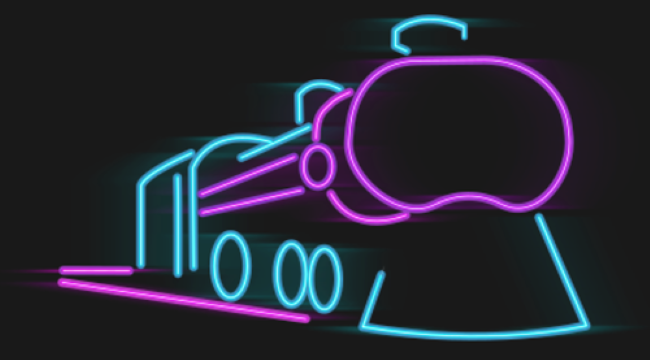
The Third Workshop on Locomotion and Wayfinding in XR, held in conjunction with IEEE VR 2025 in Saint-Malo, France, is dedicated to advancing research and fostering discussions around the critical topics of navigation in extended reality (XR). Navigation is a fundamental form of user interaction in XR, yet it poses numerous challenges in conceptual design, technical implementation, and systematic evaluation. By bringing together researchers and practitioners, this workshop aims to address these challenges and push the boundaries of what is achievable in XR navigation.
@inproceedings{Weissker2025,
author={T. {Weissker} and D. {Zielasko}},
booktitle={2025 IEEE Conference on Virtual Reality and 3D User Interfaces Abstracts and Workshops (VRW)},
title={The Third Workshop on Locomotion and Wayfinding in XR (LocXR)},
year={2025},
volume={},
number={},
pages={239-240},
doi={10.1109/VRW66409.2025.00058}
}
PASCAL - A Collaboration Technique Between Non-Collocated Avatars in Large Collaborative Virtual Environments
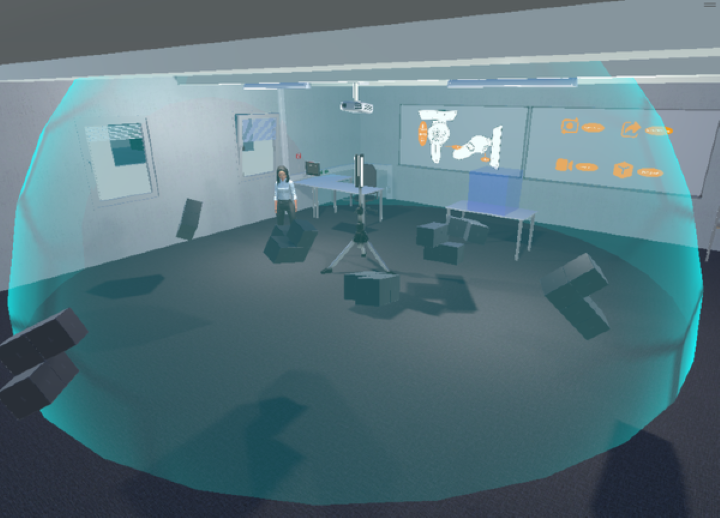
Collaborative work in large virtual environments often requires transitions from loosely-coupled collaboration at different locations to tightly-coupled collaboration at a common meeting point. Inspired by prior work on the continuum between these extremes, we present two novel interaction techniques designed to share spatial context while collaborating over large virtual distances. The first method replicates the familiar setup of a video conference by providing users with a virtual tablet to share video feeds with their peers. The second method called PASCAL (Parallel Avatars in a Shared Collaborative Aura Link) enables users to share their immediate spatial surroundings with others by creating synchronized copies of it at the remote locations of their collaborators. We evaluated both techniques in a within-subject user study, in which 24 participants were tasked with solving a puzzle in groups of two. Our results indicate that the additional contextual information provided by PASCAL had significantly positive effects on task completion time, ease of communication, mutual understanding, and co-presence. As a result, our insights contribute to the repertoire of successful interaction techniques to mediate between loosely- and tightly-coupled work in collaborative virtual environments.
@article{Gilbert2025,
author={D. {Gilbert} and A. {Bose} and T. {Kuhlen} and T. {Weissker}},
journal={IEEE Transactions on Visualization and Computer Graphics},
title={PASCAL - A Collaboration Technique Between Non-Collocated Avatars in Large Collaborative Virtual Environments},
year={2025},
volume={31},
number={5},
pages={1268-1278},
doi={10.1109/TVCG.2025.3549175}
}
Minimalism or Creative Chaos? On the Arrangement and Analysis of Numerous Scatterplots in Immersi-ve 3D Knowledge Spaces

Working with scatterplots is a classic everyday task for data analysts, which gets increasingly complex the more plots are required to form an understanding of the underlying data. To help analysts retrieve relevant plots more quickly when they are needed, immersive virtual environments (iVEs) provide them with the option to freely arrange scatterplots in the 3D space around them. In this paper, we investigate the impact of different virtual environments on the users' ability to quickly find and retrieve individual scatterplots from a larger collection. We tested three different scenarios, all having in common that users were able to position the plots freely in space according to their own needs, but each providing them with varying numbers of landmarks serving as visual cues - an Emptycene as a baseline condition, a single landmark condition with one prominent visual cue being a Desk, and a multiple landmarks condition being a virtual Office. Results from a between-subject investigation with 45 participants indicate that the time and effort users invest in arranging their plots within an iVE had a greater impact on memory performance than the design of the iVE itself. We report on the individual arrangement strategies that participants used to solve the task effectively and underline the importance of an active arrangement phase for supporting the spatial memorization of scatterplots in iVEs.
@article{Derksen2025,
author={M. {Derksen} and T. {Kuhlen} and M. {Botsch} and T. {Weissker}},
journal={IEEE Transactions on Visualization and Computer Graphics},
title={Minimalism or Creative Chaos? On the Arrangement and Analysis of Numerous Scatterplots in Immersive 3D Knowledge Spaces},
year={2025},
volume={31},
number={5},
pages={746-756},
doi={10.1109/TVCG.2025.3549546}
}
Previous Year (2024)

